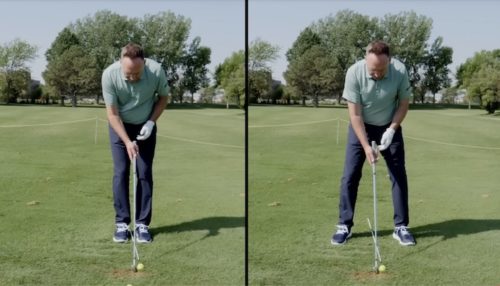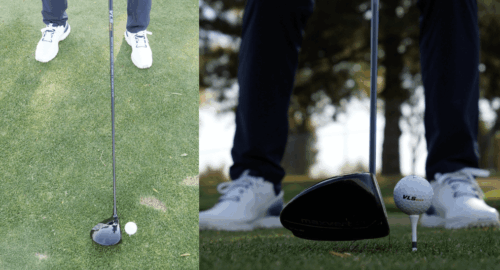The Easiest Swing for Senior Golfers (3 Easy Steps!)
Learn the Easiest Swing for Senior Golfers and Instantly Transform Your Game.
Let’s stop making this harder than it has to be.
Your golf swing really only comes down to three things:
- A good setup
- A proper pivot
- The correct arm swing
And I’ve got a strong suspicion you’re overthinking all three. Most amateur golfers do.
And most senior golfers get locked into old tips that really only work for younger bodies. How are you supposed to improve your distance and contact if you’re already having to fight a limited range of motion and over-complicated technique?
So let’s simplify. You’re about to learn the easiest swing for senior golfers, broken down into three straightforward steps.
You’ll be blown away by what a difference “easy” can make.
The Easiest Swing for Senior Golfers: Key Points
- For iron shots, set up with your golf ball slightly forward in your stance.
- For driver shots, set up with your golf ball farther forward in your stance.
- For both iron and driver shots, you want to master the pivot by shifting your weight between your feet throughout your swing.
- Think of your arms making a circle as you swing the club, arcing back until your hands are a little above your trail shoulder, then swinging back through to finish slightly above your lead shoulder.
The Easiest Swing for Seniors in 3 Steps
Step 1: Set Up Properly
If you’ve ever set out to improve your setup, you know this topic can get really complicated really fast. Honestly, I could talk for hours about this.
But I don’t have to. I can teach you one move that’ll instantly improve your contact.
That said, this strategy varies slightly depending on whether you’re hitting an iron or a driver. Let me explain:
Proper Iron Setup
As you probably know, you want to hit down on your irons. That is to say, you want to make contact with the golf ball when the clubhead is still traveling at a downward angle.
To pull that off, you’ve got to make sure your ball is at or slightly behind the low point of your swing. Once the clubhead hits the low point, it starts traveling upward again.
How to find the right ball position for irons:
- Stand with your feet together and the golf ball aligned with the center of your stance.
- Step your lead foot toward the target.
- Take a slightly larger step to move your trail foot away from the target. For example, if you stepped your lead foot 4” toward the target, you’d want to step your trail foot about 5” away from the target. (That’s just an illustration; your exact distances will vary depending on the natural width of your stance.)

Once you’ve done that, your ball should be slightly forward of center, ensuring that your clubhead makes contact at the right moment.
This exercise also has a way of getting you naturally squared up to the target.
Proper Driver Setup
Now, with a driver, you have the opposite goal. You want to make impact on an upward angle. That’s why you tee up the golf ball, right?
This means the ball needs to be in front of the low point so you can catch when the clubhead starts traveling back up. So we’ve got to get the ball even more forward in your stance.
How to find the right ball position for drivers:
- Stand with your feet together and the golf ball aligned with the center of your stance.
- Take a small step toward the target with your lead foot.
- Take a much larger step away from the target with your trail foot.

You want to end up with the golf ball just off the inside of your lead arm or lead heel.
From here on out, everything else is the same whether you’re working with an iron or a driver.
Step 2: Pivot Properly
This step is absolutely crucial, especially if you’re struggling with distance. In fact, this is one of my best tips for senior golfers who want more clubhead speed. A proper pivot is a pain-free strategy for generating more power—no flexibility needed.
When I refer to the pivot, I’m talking about the movement of the pressure in your feet throughout the swing. You’ve got to shift the weight between your feet as you swing back and through, like this:
- Set up with about 60% of your weight on your lead foot.
- Shift that weight to your trail foot on the backswing.
- Shift pressure back to the lead foot as you swing through so you finish with almost all your weight on the lead foot.
Now, I’ve got a great drill I use to help my students get the hang of this.
Right, Left Drill
- Take your regular setup without the golf ball. Make sure you’re set up with about 60% of your weight on your lead foot.
- As you swing back, say or think “right” and shift your weight to your right foot.
- As you swing forward, say or think “left” and shift your weight to your left foot.
- Do this continuously with no pauses between swings. Keep thinking or saying “right, left, right, left, right, left” and focus on shifting the pressure in your feet.
- Once you have a good feel for it, step up to the golf ball and take your shot, still thinking or saying “right, left” during your motion.
It probably goes without saying, but if you’re left-handed, you’ll want to reverse those instructions. For you, this is the Left, Right Drill.
This drill helps you really key into that weight shift so the pivot becomes a natural part of your swing. And that’s going to give you a lot more clubhead speed without having to do crazy maneuvers that can sabotage your contact.
Step 3: Master Your Arm Swing
This couldn’t be simpler. All you need to know here is that in a good golf swing, your arms almost make a full circle.
To get the feel of it, try this:
- Take your regular setup without the golf ball.
- Swing back until your hands are just above your trail shoulder.
- Swing through until your hands are just above your lead shoulder.
- Repeat, doing a few continuous swings to get the feel for it in your body.
- Step up to the ball and take your shot, making sure to get your hands just above your shoulder on both the backswing and the finish.

This is going to get you a longer, more controlled swing for longer, more controlled golf shots.
What is the Easiest Swing for Senior Golfers?
You’ve got the gist of it right here:
- Position the ball slightly forward of the center of your stance if you’re hitting an iron or off the lead heel if you’re hitting a driver
- Pivot—shift the weight between your feet as you swing back and through
- Trace a circle with your arms when you swing
Want to go a little deeper? Maybe learn how to generate more clubhead speed, fix common swing faults, or even apply senior-friendly tactics to every part of your game?
Check out my bestselling book The Bad Lie: Why Traditional Golf Instruction is Failing You (And What to Do Instead). This book teaches you my entire Vertical Line Swing System, a tee-to-green strategy designed to work with the senior golfer’s strengths instead of forcing them to fight with their weaknesses.
You don’t need complicated wrist angles or precision timing. You just need a simple, straightforward approach created for you.
What do you think?
Does this advice make sense to you? Do you have any questions or want to share a difference of opinion?
The comments are open and we love hearing from you. Jump in and share your thoughts!
If you’re ready to take your game to the next level with customized coaching or one-on-one instruction, visit us at VLSCoaching.com. Or drop us an email at Info@VLSGolf.com and put COACHING in the subject line. We’ll get back to you right away.
About the Author
I’m PGA Teaching Professional Todd Kolb—a four-time Golf Digest Best-in-State Instructor, Amazon Best-selling Author, and Minnesota PGA Teacher of the Year. I’ve worked with students of all ages and skill levels in my 30 years of coaching, from first-timers to an LPGA major champion. I’m also the Director of Instruction for VLS Golf and USGolfTV.
My work with VLS Golf and USGolfTV revolves around helping the everyday golfer cut through overcomplicated traditional instruction to find solutions that actually work for them.
 |
|

